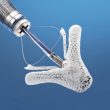Deep vein Arterialization in patients with critical “non-revascularizable” limb ischemia. We are familiar with the poor quality of life and elevated mortality of patients with chronic limb-threatening ischemia (CLTI). In its last stages (nearly terminal), revascularization (either surgical or endovascular) has been shown to reduce amputation incidence. However, similarly to heart disease and other vascular scenarios,...
MitraScore: What Does the Final Result of Edge-to-Edge Treatment of Mitral Regurgitation Provide?
Edge-to-edge treatment has proven to be a safe and effective technique in follow-up, decreasing mortality and hospitalizations for heart failure when a good result is achieved. The MitraScore was developed to assess the outcome at the end of the procedure. In that sense, results <3 represent mild mitral regurgitation, which would be related to lower...
04/12 – SOLACI@Medtronic Webinar: Lifetime Management Applied to Clinical Practice
Next Wednesday, April 12, at 8:00 p.m. (Argentina / Brazil time), we will hold a new open event in conjunction with Medtronic on “Lifetime Management Applied to Clinical Practice: Structural valve deterioration,coronary access and redo TAVR”. The event will be attended by prominent and prominent speakers and panelists. Date: April 12, 2023 at 8:00 PM...
SAFE-AAA: Are the New Endologix Devices for Abdominal Aortic Aneurysm Safe? 3-Year Followup
New unibody endologix endografts for the endovascular repair of abdominal aortic aneurysm 3-4-year safety followup At present, we have seen endovascular intervention of abdominal aortic aneurysm (EVAR) increase over surgical repair. However, the procedure is not free from complications, endoleak being the most frequent. Indeed, according to different series, it has a 20-25% incidence in AAA. Most...
Left Main Coronary Artery Revascularization: Are Periprocedural Complications Significant?
In the field of percutaneous coronary intervention (PCI) and myocardial revascularization surgery (MRS), previous analyses have shown a link between in-hospital and 30-day complications, in terms of complicated progress and/or mortality. Most of this information comes from non-randomized or old studies, which translates into contradictory data. Researchers analyzed the EXCEL study, which included patients with...
TriClip: Tricuspid Regurgitation Dedicated Device
Severe tricuspid regurgitation (TR) is difficult to manage and is associated to high morbimortality. Surgical repair is complex and not free from complications: its mortality rate ranges from 5 to 20% and depends on series, surgeon and center expertise. Edge-to-edge repair with clips has become a valid alternative to treat this disease, but most data...
COAPT: Promising 5-Year Outcomes
Secondary ischemic and non-ischemic mitral valve failure (SMR), produce left ventricle dilation, papillary muscle displacement, and impaired leaflet closure causing regurgitation. This will lead to ventricular function deterioration and bad prognosis. Edge-to-edge mitral valve repair with MitraClip has been shown safe and effective to treat SMR in the short term, but its evolution at 5...
ACC 2023 | RENOVATE-COMPLEX-PCI: Intravascular Imaging-Guided vs. Angiography-Guided Complex PCI
Patients with complex coronary artery disease (CAD) undergoing percutaneous coronary intervention (PCI) have worse clinical outcomes tan patients with non-complex CAD. Several studies have shown that the use of intravascular imaging (IVUS, OCT) have reduced major adverse events vs. angiography guided PCI. However, these studies present limitations both of size, studied population, short term followup...
ACC 2023 | Complete Revascularization Strategies in patients with ACS and Multivessel Disease
In patients with acute coronary syndrome (ACS) and multivessel disease, complete revascularization is associated with better clinical outcomes. However, for non-culprit vessel revascularization the strategy remains unclear. The aim of this multicenter, open label, randomized, non-inferiority study, was to determine whether complete revascularization during index procedure is non inferior vs. staged. Primary end point was...
Coronary Physiology after Aortic Valve Intervention
Impact of Aortic Valve Intervention on Coronary Flow Reserve Myocardial flow might be compromised in patients with severe aortic stenosis, which might be driven by CAD and concomitant atherosclerosis or a compromised capillary bed. Capillary circulation might be compromised by increased left ventricular mass (LVM) which in turn might alter coronary flow reserve (CFR). Multiple...








